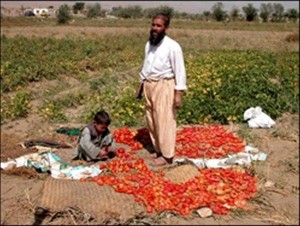Home » Reports & Data » Progress » Transforming Lives » Creating Canal-Irrigated Land In Afghanistan

Nadir, a farmer in Baghram, says his irrigation has improved significantly in 2003, even at 6.5km from the Ghorband dams.
Matt Herrick
USAID helps hundreds of villagers implement region’s largest irrigation project to date
1 DECEMBER 2003 | CHARIKAR DISTRICT, PARWAN PROVINCE
Challenge
The collapsed and broken skeletons of washed-out dams were clearly visible under the rushing waters of the Ghorband River in Parwan’s Charikar district. Heaps of stone and sandbags were no match for the powerful spring floods that carry boulders the size of small cars. For years, the task of building and maintaining the dams, as well as clearing the canals of debris, was the responsibility of area farmers. They performed this work on an irregular, ad hoc basis under extreme conditions with local conflict concerning water rights. Farmers would often leave their land for weeks at a time to band together to build the new dams or clean the canals.
Initiative
USAID has funded a program to build three water diversion dams and four canal structures along the Ghorband River. The project utilizes local, cash-for-work incentives over seventeen months to build industry standard — reinforced concrete and strong stonemasonry — structures capable of withstanding the harsh Spring-time floods. In all, the structures feed nearly 30,000 hectares of land and 74 kilometers of canals through four intakes. USAID partners also met continuously with the local community to improve the water management system.
The villagers built the protection walls, intakes, and dams with over 1,000 bags of cement, and implemented invaluable new practices — such as mixing cement during the winter — which they learned from USAID’s implementing partner
Results
The project is 95% complete and has already benefited nearly 300,000 people in 82 villages by increasing canal-irrigated land by nearly 40 percent. Community meetings held by the local mirab, or water man, has assuaged concerns over water rights and produced a respected schedule of canal maintenance by area farmers.
The program’s impact has changed the lives of many Afghan villagers, considering that nearly 75 percent of returnees in 2002 — mostly from Pakistan and Iran who fled during the Taliban government — did not have farmland. Having helped to build the irrigation system, the villagers can return to their primary method for earning income — farming. In 2003, wheat production in Parwan increased by 30 percent and corn production by over 11 percent.







Comment
Make a general inquiry or suggest an improvement.